ECU ENS3243 Report: History of Indigenous Australians Treatment
VerifiedAdded on 2023/03/20
|7
|1989
|94
Report
AI Summary
This reflective report delves into the history of the treatment of Indigenous Australians over the past century, focusing on the assimilation policies and their impact on Aboriginal communities. It highlights the harsh treatment, including the removal of children, lack of access to education, and exploitation. The report then explores the ethical considerations for engineers, emphasizing the importance of understanding cultural values, resource management, and community engagement. It discusses the significance of interconnected resources like waterways and the need for ethical decision-making in resource planning, considering indigenous representation and participation. The report concludes by emphasizing the importance of building trust with Aboriginal communities, understanding their perspectives, and incorporating their values into engineering practices to ensure respectful and equitable outcomes.
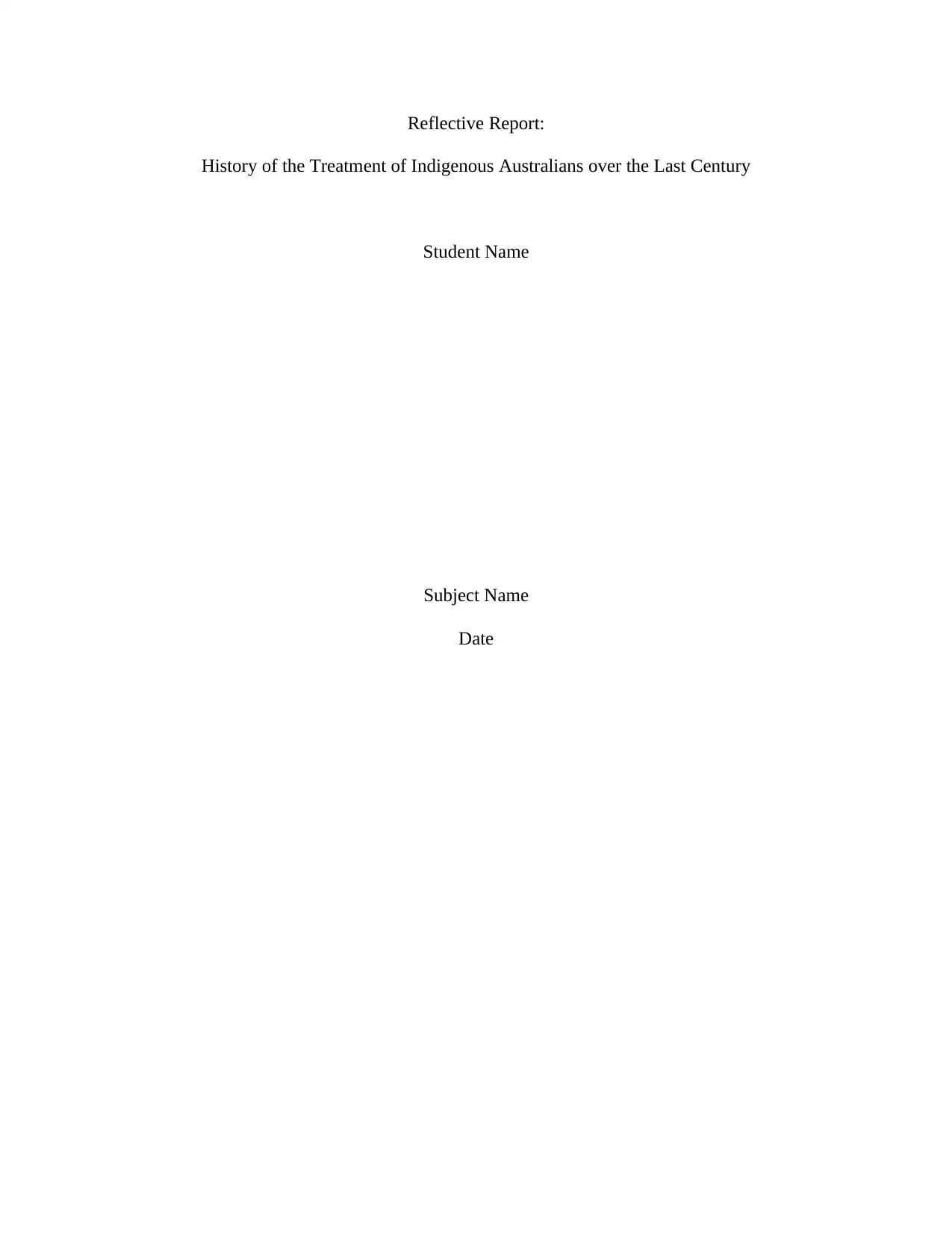
Reflective Report:
History of the Treatment of Indigenous Australians over the Last Century
Student Name
Subject Name
Date
History of the Treatment of Indigenous Australians over the Last Century
Student Name
Subject Name
Date
Paraphrase This Document
Need a fresh take? Get an instant paraphrase of this document with our AI Paraphraser
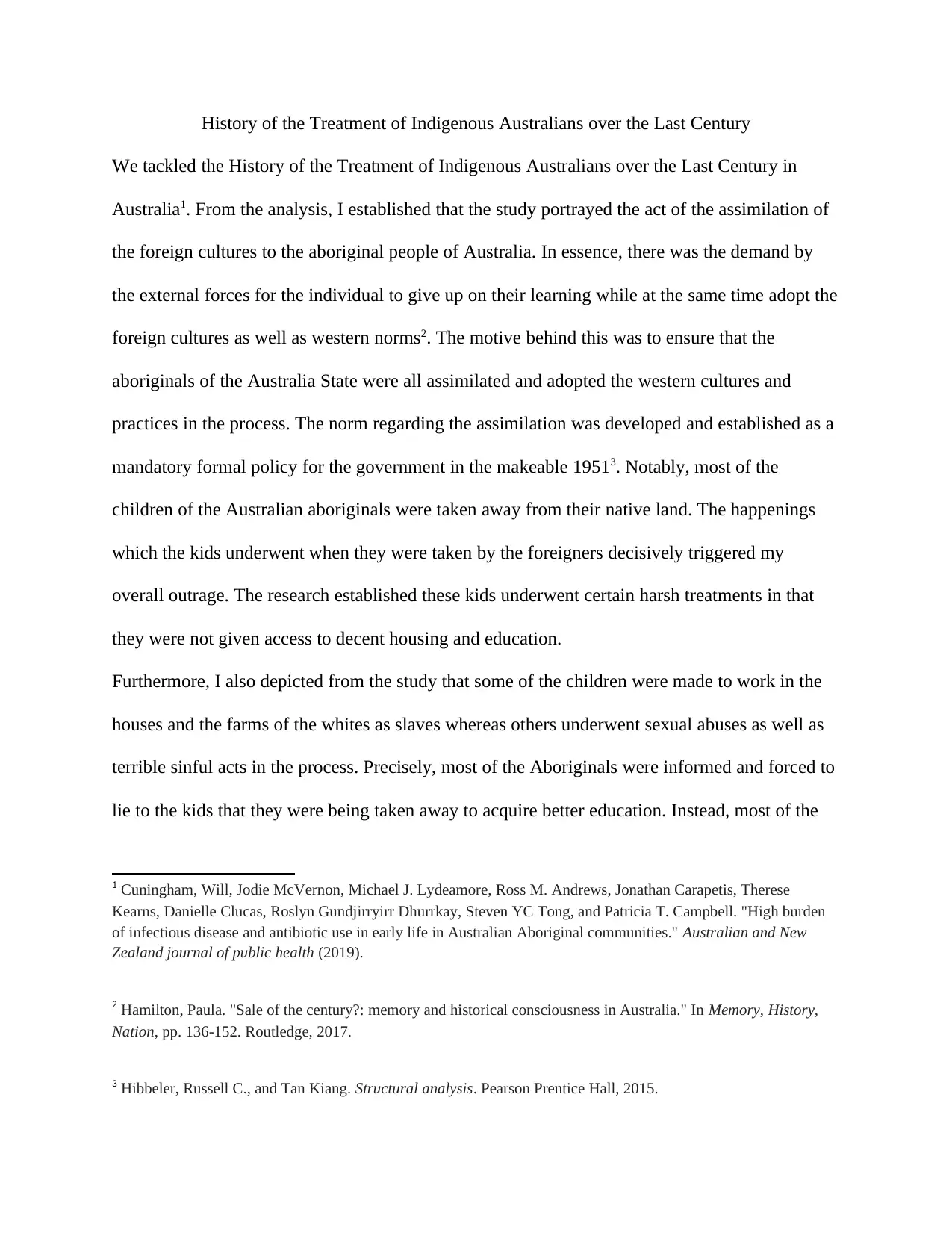
History of the Treatment of Indigenous Australians over the Last Century
We tackled the History of the Treatment of Indigenous Australians over the Last Century in
Australia1. From the analysis, I established that the study portrayed the act of the assimilation of
the foreign cultures to the aboriginal people of Australia. In essence, there was the demand by
the external forces for the individual to give up on their learning while at the same time adopt the
foreign cultures as well as western norms2. The motive behind this was to ensure that the
aboriginals of the Australia State were all assimilated and adopted the western cultures and
practices in the process. The norm regarding the assimilation was developed and established as a
mandatory formal policy for the government in the makeable 19513. Notably, most of the
children of the Australian aboriginals were taken away from their native land. The happenings
which the kids underwent when they were taken by the foreigners decisively triggered my
overall outrage. The research established these kids underwent certain harsh treatments in that
they were not given access to decent housing and education.
Furthermore, I also depicted from the study that some of the children were made to work in the
houses and the farms of the whites as slaves whereas others underwent sexual abuses as well as
terrible sinful acts in the process. Precisely, most of the Aboriginals were informed and forced to
lie to the kids that they were being taken away to acquire better education. Instead, most of the
1 Cuningham, Will, Jodie McVernon, Michael J. Lydeamore, Ross M. Andrews, Jonathan Carapetis, Therese
Kearns, Danielle Clucas, Roslyn Gundjirryirr Dhurrkay, Steven YC Tong, and Patricia T. Campbell. "High burden
of infectious disease and antibiotic use in early life in Australian Aboriginal communities." Australian and New
Zealand journal of public health (2019).
2 Hamilton, Paula. "Sale of the century?: memory and historical consciousness in Australia." In Memory, History,
Nation, pp. 136-152. Routledge, 2017.
3 Hibbeler, Russell C., and Tan Kiang. Structural analysis. Pearson Prentice Hall, 2015.
We tackled the History of the Treatment of Indigenous Australians over the Last Century in
Australia1. From the analysis, I established that the study portrayed the act of the assimilation of
the foreign cultures to the aboriginal people of Australia. In essence, there was the demand by
the external forces for the individual to give up on their learning while at the same time adopt the
foreign cultures as well as western norms2. The motive behind this was to ensure that the
aboriginals of the Australia State were all assimilated and adopted the western cultures and
practices in the process. The norm regarding the assimilation was developed and established as a
mandatory formal policy for the government in the makeable 19513. Notably, most of the
children of the Australian aboriginals were taken away from their native land. The happenings
which the kids underwent when they were taken by the foreigners decisively triggered my
overall outrage. The research established these kids underwent certain harsh treatments in that
they were not given access to decent housing and education.
Furthermore, I also depicted from the study that some of the children were made to work in the
houses and the farms of the whites as slaves whereas others underwent sexual abuses as well as
terrible sinful acts in the process. Precisely, most of the Aboriginals were informed and forced to
lie to the kids that they were being taken away to acquire better education. Instead, most of the
1 Cuningham, Will, Jodie McVernon, Michael J. Lydeamore, Ross M. Andrews, Jonathan Carapetis, Therese
Kearns, Danielle Clucas, Roslyn Gundjirryirr Dhurrkay, Steven YC Tong, and Patricia T. Campbell. "High burden
of infectious disease and antibiotic use in early life in Australian Aboriginal communities." Australian and New
Zealand journal of public health (2019).
2 Hamilton, Paula. "Sale of the century?: memory and historical consciousness in Australia." In Memory, History,
Nation, pp. 136-152. Routledge, 2017.
3 Hibbeler, Russell C., and Tan Kiang. Structural analysis. Pearson Prentice Hall, 2015.
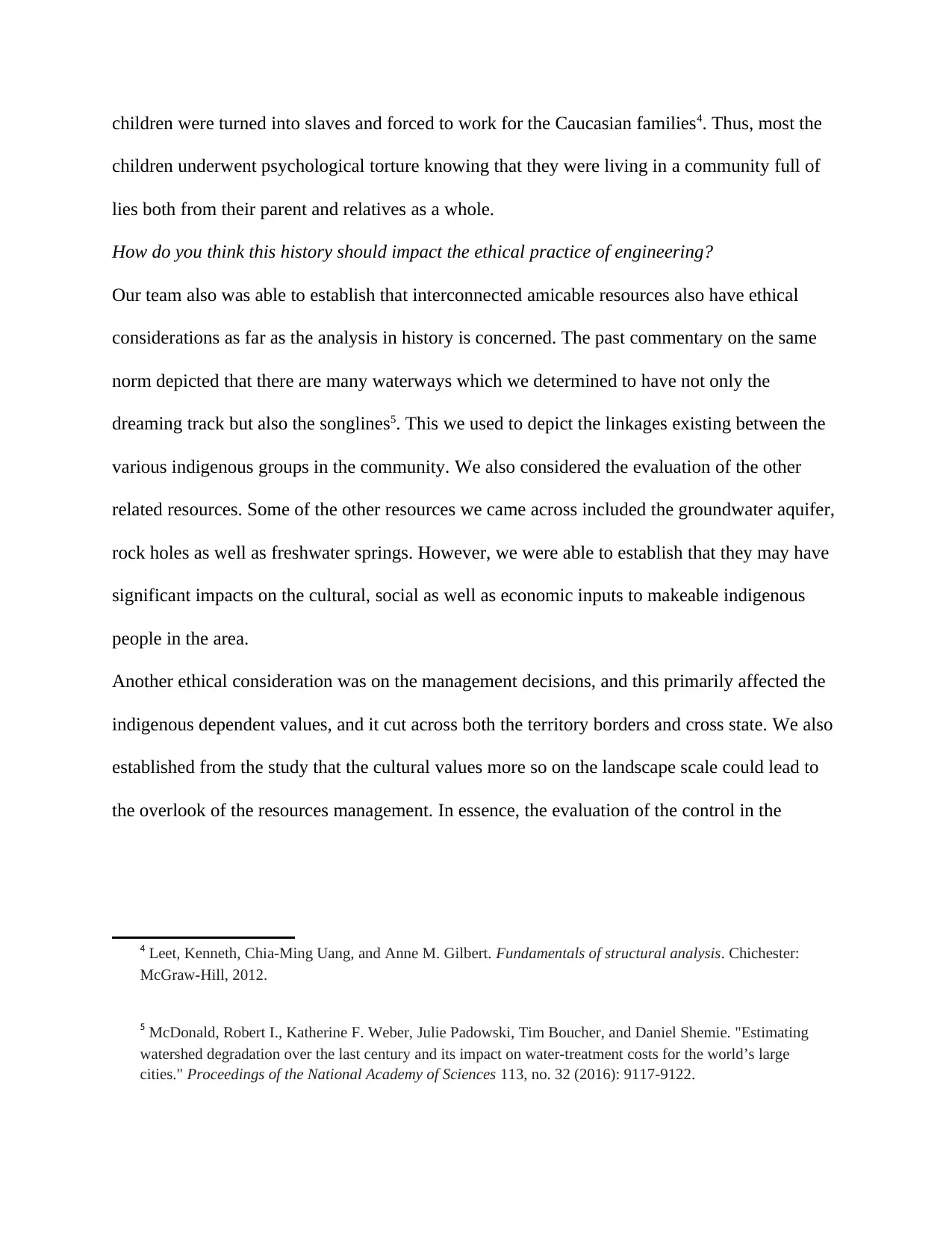
children were turned into slaves and forced to work for the Caucasian families4. Thus, most the
children underwent psychological torture knowing that they were living in a community full of
lies both from their parent and relatives as a whole.
How do you think this history should impact the ethical practice of engineering?
Our team also was able to establish that interconnected amicable resources also have ethical
considerations as far as the analysis in history is concerned. The past commentary on the same
norm depicted that there are many waterways which we determined to have not only the
dreaming track but also the songlines5. This we used to depict the linkages existing between the
various indigenous groups in the community. We also considered the evaluation of the other
related resources. Some of the other resources we came across included the groundwater aquifer,
rock holes as well as freshwater springs. However, we were able to establish that they may have
significant impacts on the cultural, social as well as economic inputs to makeable indigenous
people in the area.
Another ethical consideration was on the management decisions, and this primarily affected the
indigenous dependent values, and it cut across both the territory borders and cross state. We also
established from the study that the cultural values more so on the landscape scale could lead to
the overlook of the resources management. In essence, the evaluation of the control in the
4 Leet, Kenneth, Chia-Ming Uang, and Anne M. Gilbert. Fundamentals of structural analysis. Chichester:
McGraw-Hill, 2012.
5 McDonald, Robert I., Katherine F. Weber, Julie Padowski, Tim Boucher, and Daniel Shemie. "Estimating
watershed degradation over the last century and its impact on water-treatment costs for the world’s large
cities." Proceedings of the National Academy of Sciences 113, no. 32 (2016): 9117-9122.
children underwent psychological torture knowing that they were living in a community full of
lies both from their parent and relatives as a whole.
How do you think this history should impact the ethical practice of engineering?
Our team also was able to establish that interconnected amicable resources also have ethical
considerations as far as the analysis in history is concerned. The past commentary on the same
norm depicted that there are many waterways which we determined to have not only the
dreaming track but also the songlines5. This we used to depict the linkages existing between the
various indigenous groups in the community. We also considered the evaluation of the other
related resources. Some of the other resources we came across included the groundwater aquifer,
rock holes as well as freshwater springs. However, we were able to establish that they may have
significant impacts on the cultural, social as well as economic inputs to makeable indigenous
people in the area.
Another ethical consideration was on the management decisions, and this primarily affected the
indigenous dependent values, and it cut across both the territory borders and cross state. We also
established from the study that the cultural values more so on the landscape scale could lead to
the overlook of the resources management. In essence, the evaluation of the control in the
4 Leet, Kenneth, Chia-Ming Uang, and Anne M. Gilbert. Fundamentals of structural analysis. Chichester:
McGraw-Hill, 2012.
5 McDonald, Robert I., Katherine F. Weber, Julie Padowski, Tim Boucher, and Daniel Shemie. "Estimating
watershed degradation over the last century and its impact on water-treatment costs for the world’s large
cities." Proceedings of the National Academy of Sciences 113, no. 32 (2016): 9117-9122.
⊘ This is a preview!⊘
Do you want full access?
Subscribe today to unlock all pages.

Trusted by 1+ million students worldwide
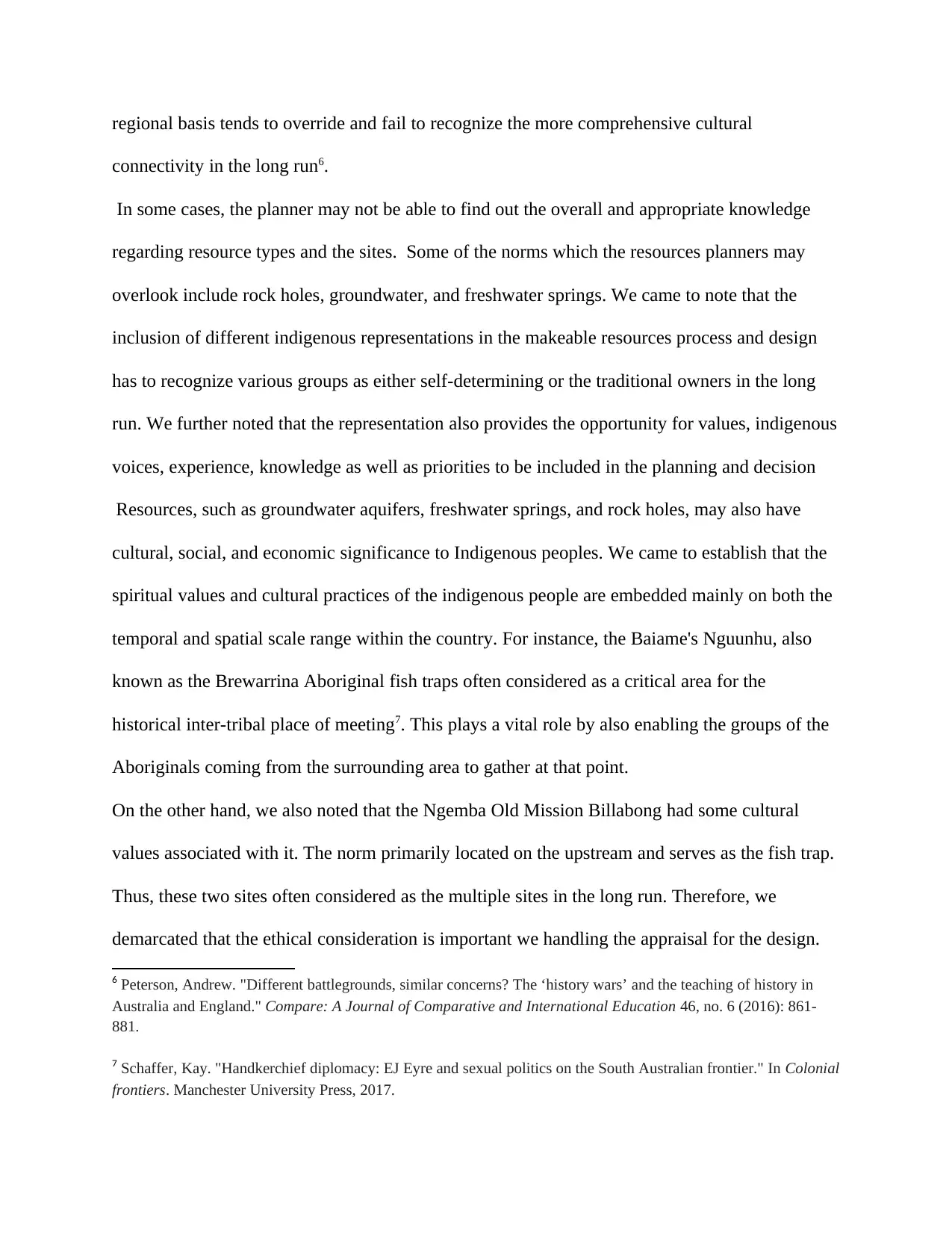
regional basis tends to override and fail to recognize the more comprehensive cultural
connectivity in the long run6.
In some cases, the planner may not be able to find out the overall and appropriate knowledge
regarding resource types and the sites. Some of the norms which the resources planners may
overlook include rock holes, groundwater, and freshwater springs. We came to note that the
inclusion of different indigenous representations in the makeable resources process and design
has to recognize various groups as either self-determining or the traditional owners in the long
run. We further noted that the representation also provides the opportunity for values, indigenous
voices, experience, knowledge as well as priorities to be included in the planning and decision
Resources, such as groundwater aquifers, freshwater springs, and rock holes, may also have
cultural, social, and economic significance to Indigenous peoples. We came to establish that the
spiritual values and cultural practices of the indigenous people are embedded mainly on both the
temporal and spatial scale range within the country. For instance, the Baiame's Nguunhu, also
known as the Brewarrina Aboriginal fish traps often considered as a critical area for the
historical inter-tribal place of meeting7. This plays a vital role by also enabling the groups of the
Aboriginals coming from the surrounding area to gather at that point.
On the other hand, we also noted that the Ngemba Old Mission Billabong had some cultural
values associated with it. The norm primarily located on the upstream and serves as the fish trap.
Thus, these two sites often considered as the multiple sites in the long run. Therefore, we
demarcated that the ethical consideration is important we handling the appraisal for the design.
6 Peterson, Andrew. "Different battlegrounds, similar concerns? The ‘history wars’ and the teaching of history in
Australia and England." Compare: A Journal of Comparative and International Education 46, no. 6 (2016): 861-
881.
7 Schaffer, Kay. "Handkerchief diplomacy: EJ Eyre and sexual politics on the South Australian frontier." In Colonial
frontiers. Manchester University Press, 2017.
connectivity in the long run6.
In some cases, the planner may not be able to find out the overall and appropriate knowledge
regarding resource types and the sites. Some of the norms which the resources planners may
overlook include rock holes, groundwater, and freshwater springs. We came to note that the
inclusion of different indigenous representations in the makeable resources process and design
has to recognize various groups as either self-determining or the traditional owners in the long
run. We further noted that the representation also provides the opportunity for values, indigenous
voices, experience, knowledge as well as priorities to be included in the planning and decision
Resources, such as groundwater aquifers, freshwater springs, and rock holes, may also have
cultural, social, and economic significance to Indigenous peoples. We came to establish that the
spiritual values and cultural practices of the indigenous people are embedded mainly on both the
temporal and spatial scale range within the country. For instance, the Baiame's Nguunhu, also
known as the Brewarrina Aboriginal fish traps often considered as a critical area for the
historical inter-tribal place of meeting7. This plays a vital role by also enabling the groups of the
Aboriginals coming from the surrounding area to gather at that point.
On the other hand, we also noted that the Ngemba Old Mission Billabong had some cultural
values associated with it. The norm primarily located on the upstream and serves as the fish trap.
Thus, these two sites often considered as the multiple sites in the long run. Therefore, we
demarcated that the ethical consideration is important we handling the appraisal for the design.
6 Peterson, Andrew. "Different battlegrounds, similar concerns? The ‘history wars’ and the teaching of history in
Australia and England." Compare: A Journal of Comparative and International Education 46, no. 6 (2016): 861-
881.
7 Schaffer, Kay. "Handkerchief diplomacy: EJ Eyre and sexual politics on the South Australian frontier." In Colonial
frontiers. Manchester University Press, 2017.
Paraphrase This Document
Need a fresh take? Get an instant paraphrase of this document with our AI Paraphraser
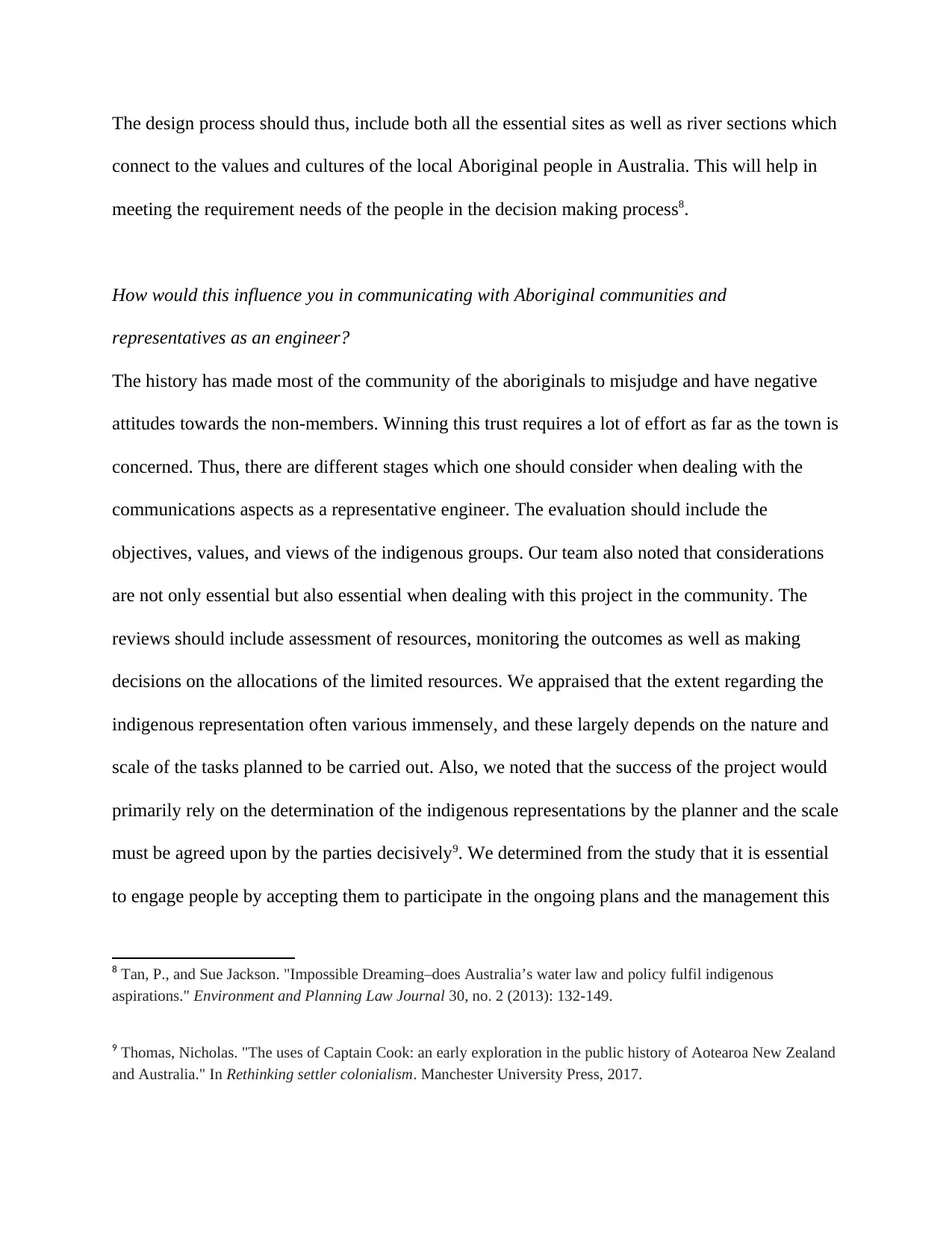
The design process should thus, include both all the essential sites as well as river sections which
connect to the values and cultures of the local Aboriginal people in Australia. This will help in
meeting the requirement needs of the people in the decision making process8.
How would this influence you in communicating with Aboriginal communities and
representatives as an engineer?
The history has made most of the community of the aboriginals to misjudge and have negative
attitudes towards the non-members. Winning this trust requires a lot of effort as far as the town is
concerned. Thus, there are different stages which one should consider when dealing with the
communications aspects as a representative engineer. The evaluation should include the
objectives, values, and views of the indigenous groups. Our team also noted that considerations
are not only essential but also essential when dealing with this project in the community. The
reviews should include assessment of resources, monitoring the outcomes as well as making
decisions on the allocations of the limited resources. We appraised that the extent regarding the
indigenous representation often various immensely, and these largely depends on the nature and
scale of the tasks planned to be carried out. Also, we noted that the success of the project would
primarily rely on the determination of the indigenous representations by the planner and the scale
must be agreed upon by the parties decisively9. We determined from the study that it is essential
to engage people by accepting them to participate in the ongoing plans and the management this
8 Tan, P., and Sue Jackson. "Impossible Dreaming–does Australia’s water law and policy fulfil indigenous
aspirations." Environment and Planning Law Journal 30, no. 2 (2013): 132-149.
9 Thomas, Nicholas. "The uses of Captain Cook: an early exploration in the public history of Aotearoa New Zealand
and Australia." In Rethinking settler colonialism. Manchester University Press, 2017.
connect to the values and cultures of the local Aboriginal people in Australia. This will help in
meeting the requirement needs of the people in the decision making process8.
How would this influence you in communicating with Aboriginal communities and
representatives as an engineer?
The history has made most of the community of the aboriginals to misjudge and have negative
attitudes towards the non-members. Winning this trust requires a lot of effort as far as the town is
concerned. Thus, there are different stages which one should consider when dealing with the
communications aspects as a representative engineer. The evaluation should include the
objectives, values, and views of the indigenous groups. Our team also noted that considerations
are not only essential but also essential when dealing with this project in the community. The
reviews should include assessment of resources, monitoring the outcomes as well as making
decisions on the allocations of the limited resources. We appraised that the extent regarding the
indigenous representation often various immensely, and these largely depends on the nature and
scale of the tasks planned to be carried out. Also, we noted that the success of the project would
primarily rely on the determination of the indigenous representations by the planner and the scale
must be agreed upon by the parties decisively9. We determined from the study that it is essential
to engage people by accepting them to participate in the ongoing plans and the management this
8 Tan, P., and Sue Jackson. "Impossible Dreaming–does Australia’s water law and policy fulfil indigenous
aspirations." Environment and Planning Law Journal 30, no. 2 (2013): 132-149.
9 Thomas, Nicholas. "The uses of Captain Cook: an early exploration in the public history of Aotearoa New Zealand
and Australia." In Rethinking settler colonialism. Manchester University Press, 2017.
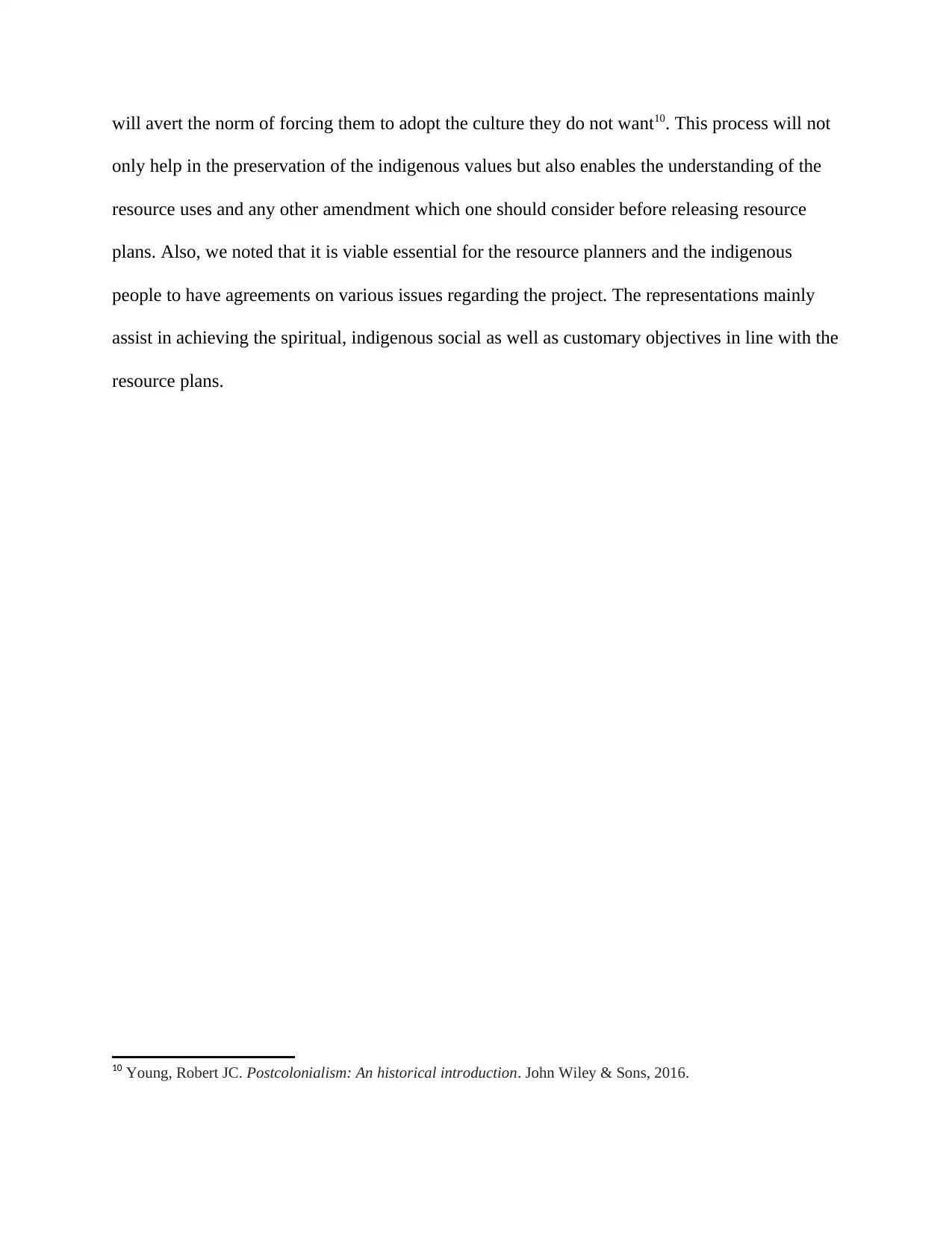
will avert the norm of forcing them to adopt the culture they do not want10. This process will not
only help in the preservation of the indigenous values but also enables the understanding of the
resource uses and any other amendment which one should consider before releasing resource
plans. Also, we noted that it is viable essential for the resource planners and the indigenous
people to have agreements on various issues regarding the project. The representations mainly
assist in achieving the spiritual, indigenous social as well as customary objectives in line with the
resource plans.
10 Young, Robert JC. Postcolonialism: An historical introduction. John Wiley & Sons, 2016.
only help in the preservation of the indigenous values but also enables the understanding of the
resource uses and any other amendment which one should consider before releasing resource
plans. Also, we noted that it is viable essential for the resource planners and the indigenous
people to have agreements on various issues regarding the project. The representations mainly
assist in achieving the spiritual, indigenous social as well as customary objectives in line with the
resource plans.
10 Young, Robert JC. Postcolonialism: An historical introduction. John Wiley & Sons, 2016.
⊘ This is a preview!⊘
Do you want full access?
Subscribe today to unlock all pages.

Trusted by 1+ million students worldwide
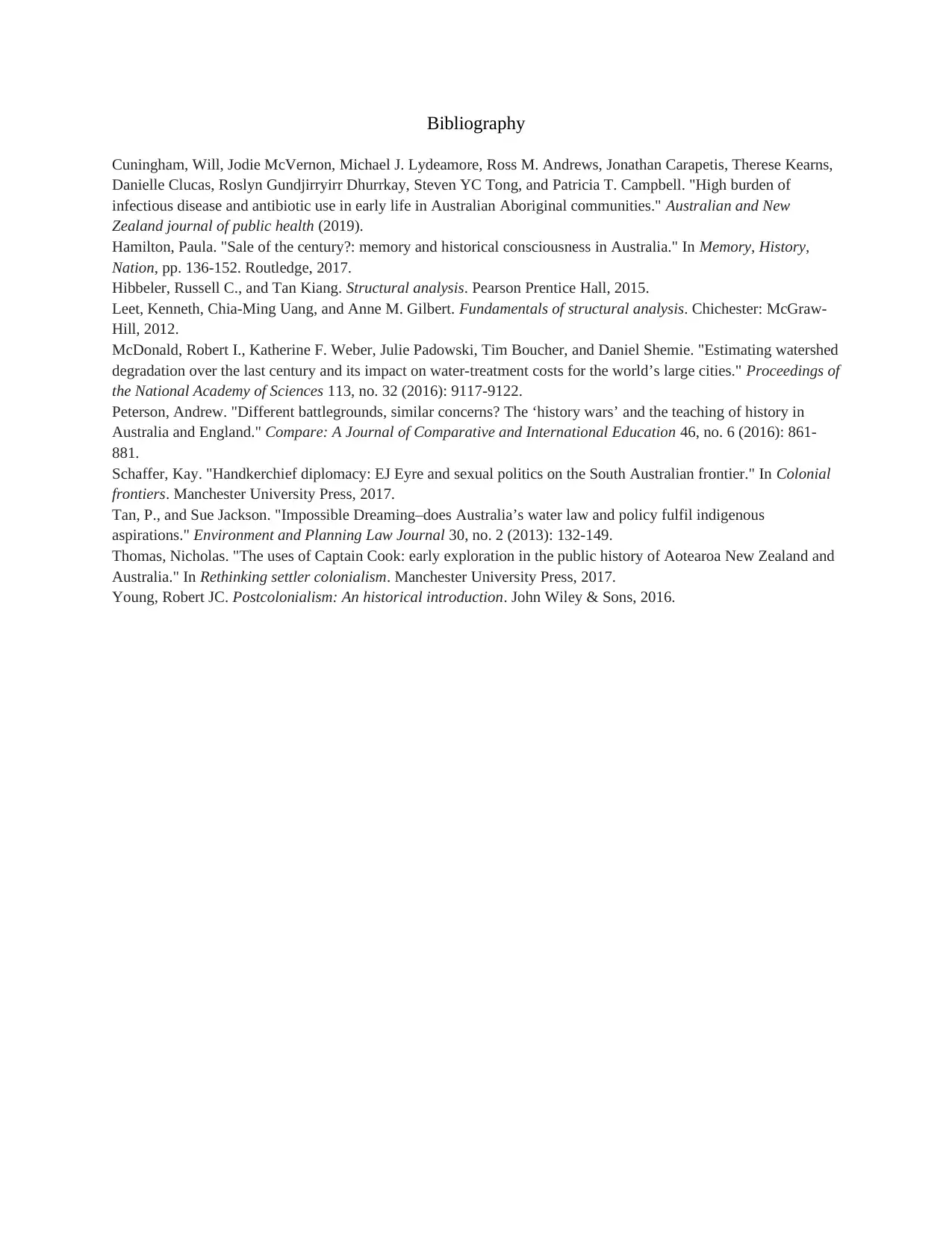
Bibliography
Cuningham, Will, Jodie McVernon, Michael J. Lydeamore, Ross M. Andrews, Jonathan Carapetis, Therese Kearns,
Danielle Clucas, Roslyn Gundjirryirr Dhurrkay, Steven YC Tong, and Patricia T. Campbell. "High burden of
infectious disease and antibiotic use in early life in Australian Aboriginal communities." Australian and New
Zealand journal of public health (2019).
Hamilton, Paula. "Sale of the century?: memory and historical consciousness in Australia." In Memory, History,
Nation, pp. 136-152. Routledge, 2017.
Hibbeler, Russell C., and Tan Kiang. Structural analysis. Pearson Prentice Hall, 2015.
Leet, Kenneth, Chia-Ming Uang, and Anne M. Gilbert. Fundamentals of structural analysis. Chichester: McGraw-
Hill, 2012.
McDonald, Robert I., Katherine F. Weber, Julie Padowski, Tim Boucher, and Daniel Shemie. "Estimating watershed
degradation over the last century and its impact on water-treatment costs for the world’s large cities." Proceedings of
the National Academy of Sciences 113, no. 32 (2016): 9117-9122.
Peterson, Andrew. "Different battlegrounds, similar concerns? The ‘history wars’ and the teaching of history in
Australia and England." Compare: A Journal of Comparative and International Education 46, no. 6 (2016): 861-
881.
Schaffer, Kay. "Handkerchief diplomacy: EJ Eyre and sexual politics on the South Australian frontier." In Colonial
frontiers. Manchester University Press, 2017.
Tan, P., and Sue Jackson. "Impossible Dreaming–does Australia’s water law and policy fulfil indigenous
aspirations." Environment and Planning Law Journal 30, no. 2 (2013): 132-149.
Thomas, Nicholas. "The uses of Captain Cook: early exploration in the public history of Aotearoa New Zealand and
Australia." In Rethinking settler colonialism. Manchester University Press, 2017.
Young, Robert JC. Postcolonialism: An historical introduction. John Wiley & Sons, 2016.
Cuningham, Will, Jodie McVernon, Michael J. Lydeamore, Ross M. Andrews, Jonathan Carapetis, Therese Kearns,
Danielle Clucas, Roslyn Gundjirryirr Dhurrkay, Steven YC Tong, and Patricia T. Campbell. "High burden of
infectious disease and antibiotic use in early life in Australian Aboriginal communities." Australian and New
Zealand journal of public health (2019).
Hamilton, Paula. "Sale of the century?: memory and historical consciousness in Australia." In Memory, History,
Nation, pp. 136-152. Routledge, 2017.
Hibbeler, Russell C., and Tan Kiang. Structural analysis. Pearson Prentice Hall, 2015.
Leet, Kenneth, Chia-Ming Uang, and Anne M. Gilbert. Fundamentals of structural analysis. Chichester: McGraw-
Hill, 2012.
McDonald, Robert I., Katherine F. Weber, Julie Padowski, Tim Boucher, and Daniel Shemie. "Estimating watershed
degradation over the last century and its impact on water-treatment costs for the world’s large cities." Proceedings of
the National Academy of Sciences 113, no. 32 (2016): 9117-9122.
Peterson, Andrew. "Different battlegrounds, similar concerns? The ‘history wars’ and the teaching of history in
Australia and England." Compare: A Journal of Comparative and International Education 46, no. 6 (2016): 861-
881.
Schaffer, Kay. "Handkerchief diplomacy: EJ Eyre and sexual politics on the South Australian frontier." In Colonial
frontiers. Manchester University Press, 2017.
Tan, P., and Sue Jackson. "Impossible Dreaming–does Australia’s water law and policy fulfil indigenous
aspirations." Environment and Planning Law Journal 30, no. 2 (2013): 132-149.
Thomas, Nicholas. "The uses of Captain Cook: early exploration in the public history of Aotearoa New Zealand and
Australia." In Rethinking settler colonialism. Manchester University Press, 2017.
Young, Robert JC. Postcolonialism: An historical introduction. John Wiley & Sons, 2016.
1 out of 7
Related Documents
Your All-in-One AI-Powered Toolkit for Academic Success.
+13062052269
info@desklib.com
Available 24*7 on WhatsApp / Email
![[object Object]](/_next/static/media/star-bottom.7253800d.svg)
Unlock your academic potential
Copyright © 2020–2025 A2Z Services. All Rights Reserved. Developed and managed by ZUCOL.





